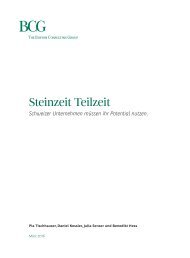Research Institute
ekthsi_0
ekthsi_0
Create successful ePaper yourself
Turn your PDF publications into a flip-book with our unique Google optimized e-Paper software.
Figure 1<br />
The global wealth pyramid<br />
34 m<br />
(0.7%)<br />
> USD 1 million<br />
USD 112.9 trn (45.2%)<br />
USD 100,000 to 1 million<br />
349 m<br />
(7.4%)<br />
USD 98.5 trn (39.4%)<br />
USD 10,000 to 100,000<br />
1,003 m<br />
(21.0%)<br />
USD 31.3 trn (12.5%)<br />
< USD 10,000<br />
3,386 m<br />
(71.0%)<br />
USD 7.4 trn (3.0%)<br />
Wealth<br />
range<br />
Number of adults (percent of world population)<br />
Total wealth<br />
(percent of world)<br />
Source: James Davies, Rodrigo Lluberas and Anthony Shorrocks, Credit Suisse Global Wealth Databook 2015<br />
Each of the remaining 383 million adults (8% of<br />
the world) has net worth above USD 100,000.<br />
This group includes 34 million US dollar millionaires,<br />
who comprise less than 1% of the world’s<br />
adult population, yet own 45% of all household<br />
wealth. We estimate that 123,800 individuals<br />
within this group are worth more than USD 50<br />
million, and 44,900 have over USD 100 million.<br />
The base of the pyramid<br />
Each layer of the wealth pyramid has distinctive<br />
characteristics. The base tier has the most even<br />
distribution across regions and countries (see<br />
Figure 2), but it is also very diverse, spanning<br />
a wide range of personal circumstances. In developed<br />
countries, only about 20% of adults fall<br />
within this category, and for the majority of these<br />
individuals, membership is either transient – due<br />
to business losses or unemployment, for example<br />
– or a lifecycle phenomenon associated with<br />
youth or old age. In contrast, more than 90%<br />
of the adult population in India and Africa falls<br />
within this range. The percentage of the population<br />
in this wealth group is close to 100% in<br />
some low-income countries in Africa. For many<br />
residents of low-income countries, life membership<br />
of the base tier is the norm rather than the<br />
exception.<br />
Mid-range wealth<br />
In the context of global wealth, USD 10,000–<br />
100,000 is the mid-range wealth band. It covers<br />
one billion adults. The average wealth holding is<br />
close to the global average for all wealth levels and<br />
the combined net worth of USD 31 trillion provides<br />
the segment with considerable economic clout.<br />
India and Africa are under-represented in this tier,<br />
whereas China’s share is relatively high. The comparison<br />
between China and India is very interesting.<br />
India accounts for just 3.4% of those with midrange<br />
wealth, and that share has changed very little<br />
during the past decade. In contrast, China accounts<br />
for 36% of those with wealth between USD 10,000<br />
and USD 100,000, ten times the number of Indians,<br />
and double the number of Chinese in 2000.<br />
Higher wealth segment of the pyramid<br />
The higher wealth segment of the pyramid – those<br />
with net worth above USD 100,000 – had 215<br />
million adult members at the start of the century.<br />
By 2014, worldwide membership had risen above<br />
395 million, but it declined this year to 383 million,<br />
another consequence of the strengthening US<br />
dollar. The regional composition of the group differs<br />
markedly from the strata below. Europe, North<br />
America and the Asia-Pacific region (omitting China<br />
24 Global Wealth Report 2015







